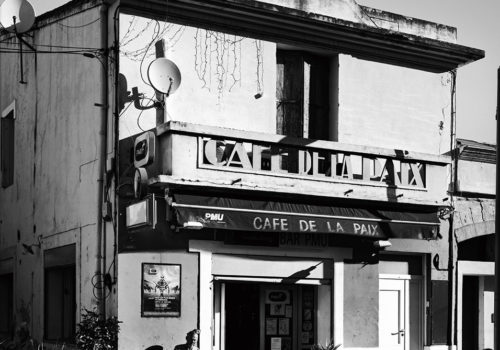The exhibition is called Raymond Depardon – Communes – It is held until April 24, 2022 at the Pavillon Populaire in Montpellier. Its curator Gilles Mora presents it as follows:
On March 1, 2010, under the presidency of Nicolas Sarkozy, the Ministry of Ecology, Energy and Sustainable Development granted a Texan company, for a period of 3 years, a hydrocarbon mine exploration permit , liquid or gaseous, known as the “Nant Permit”. The operating perimeter concerned (4400 square km) is located in the south-east of France, mainly in the Occitanie region. Nearly 280 municipalities and more than half a million inhabitants are affected. It is therefore a territory with major natural and tourist resources which is thus threatened, an eminently rural region (Larzac, Auvergne, Ardèche, Drôme, Hérault…) with a fragile fabric. We know the brutality of shale gas exploitation: geological fractures and their attendant side effects that are fatal to the environment. The conclusion of this project is known: a revolt and citizen mobilization led by left-wing environmental and political movements led, in 2011, to the repeal of the “Nant Permit”, then upheld in court in 2015. However within the populations initially concerned, a deep traumatism remains, so much was challenged concerning the balance of these rural communes.
The day after the first confinement following the Covid epidemic, the photographer Raymond Depardon, during the summer of 2020, resumed his activity as an image maker after the forced sanitary immobilization: it would be, with a need for light and space, the exploration of these villages of the Mediterranean hinterland that escaped the ecological disaster of the “Permis de Nant”.
Accustomed to the photographic recording of the agricultural France in which he was born and of which, with lucidity, he noted the fragility as much as the resistance, Depardon could only carry out such a project in the state of mind which is his own: empathy for the villages visited, increasingly contemplative photographic strategy, to such an extent that this photographic essay is situated in places of his previous activity as a reporter for Gamma and then Magnum photos agencies. Since the 2000s, Depardon seems to have migrated from the chaos of civil, political or social unrest, towards a much more restrained temporality, that of landscapes and rural traces, which are the basis of the content of his large book Rural (2020), still close to a documentary reportage. With a new vision, new technique. The partial abandonment of the small format, emblematic of photo-journalism, now gives way to the strategy of scrutinizing using large format camer, its slowness, its ceremonial. The twirling model of the street photographer or the reporter in perpetual motion, in a hurry to mark reality sticking to it like glue, is replaced by the attentive observer, master of his time, faced with a more timeless reality, the one chosen by the American Edward Weston, and the German Albert Renger-Patzsch, in a contemplative attitude before the beauties of the world.
Communes clearly derives from this aesthetic of the static, of the immemorial, which only the practice of large format can accurately grasp, redoubled, here, by the use of black and white, which reinforces the abstractive virtues of the architectures in front of which Depardon placed himself, in the angular games of shadows and light. This atavistic delicacy, so specific to Mediterranean climates, Depardon celebrates it over and over again and in a spirit of formal jubilation, especially since it was nearly engulfed in the abyss of the “Permis de Nant”. Sculptural images, new to Depardon, which seem to rule out any human presence. It would be a mistake to believe, however, in such a voluntary abandonment, in a photographer usually attentive to the social games of hyper-mediatized characters, as well as those of modest or anonymous actors.
Unlike his opus Rural, Communes seems to deal more with the landscape, less the people who inhabit it. As a good Balzacian, and an attentive admirer of one of his great models, Walker Evans, Raymond Depardon multiplies in the apparently deserted images of these villages, the often subtle, but always omnipresent ghostly traces of inhabitants, including a sheet drying at the windows, the distribution of garden seats in an interior courtyard, an abandoned scooter at the foot of a house, that signal a discreet but insistent human presence, although slyly threatened (how many shutters closed in the photographs taken by Depardon…). The traces here are valid for those who leave them, religious and profane spirits coexist through the pediments of churches and town halls.
More than the nostalgic report of a mineral and solar territory to which, in the aftermath of the ordeal of the first confinement, he felt even closer, Communes by Raymond Depardon is offered to be read like a photographic manifesto, come to affirm the virtues of a contemplative revival, now seeming to affect a whole section of contemporary photography.
Gilles Mora, Artistic Director of the Pavillon Populaire and curator of the exhibition.
The photographs were taken by Raymond Depardon with an Ebony 8 x 10 camera equipped with a 300 mm Rodenstock lens and with CatLABS film.
Raymond Depardon: Communes
From February 16 to April 24, 2022
Pavillon Populaire, Espace d’Art photographique de la Ville de Montpellier
Esplanade Charles de Gaulle
34000 Montpellier, France
https://www.montpellier.fr/506-les-expos-du-pavillon-populaire-a-montpellier.htm
















